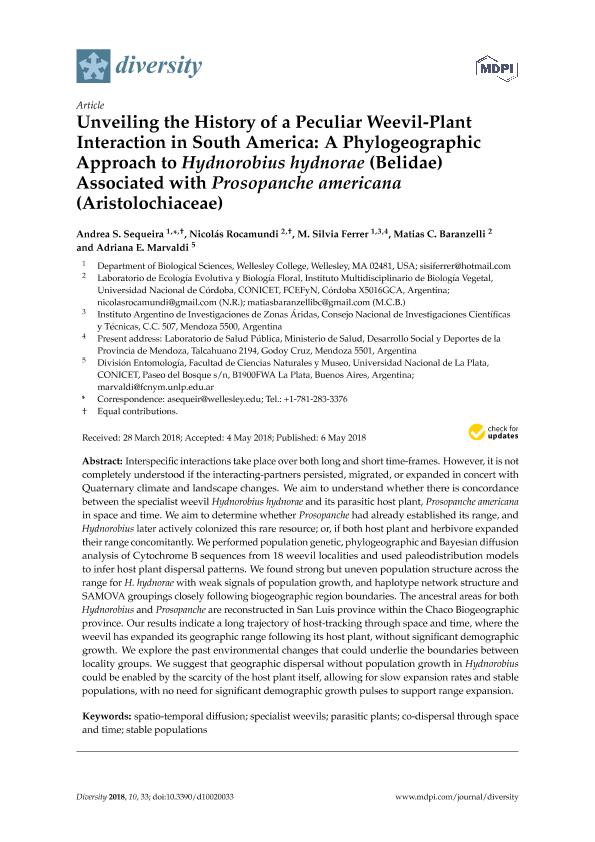Mostrar el registro sencillo del ítem
dc.contributor.author
Sequeira, Andrea S.
dc.contributor.author
Rocamundi, Nicolás

dc.contributor.author
Ferrer, Maria Silvia

dc.contributor.author
Baranzelli, Matias Cristian

dc.contributor.author
Marvaldi, Adriana

dc.date.available
2019-10-22T17:13:41Z
dc.date.issued
2018-05
dc.identifier.citation
Sequeira, Andrea S.; Rocamundi, Nicolás; Ferrer, Maria Silvia; Baranzelli, Matias Cristian; Marvaldi, Adriana; Unveiling the History of a Peculiar Weevil-Plant Interaction in South America: A Phylogeographic Approach to Hydnorobius hydnorae (Belidae) Associated with Prosopanche americana (Aristolochiaceae); MDPI; Diversity; 10; 33; 5-2018; 1-24
dc.identifier.issn
1424-2818
dc.identifier.uri
http://hdl.handle.net/11336/86894
dc.description.abstract
Interspecific interactions take place over both long and short time-frames. However it is not completely understood if the interacting-partners persisted, migrated, or expanded in concert with Quaternary climate and landscape changes. We aim to understand whether there is concordance between the specialist weevil Hydnorobius hydnorae and its parasitic host plant, Prosopanche Americana, in space and time. We aim to determine whether Prosopanche had already established its range, and Hydnorobius later actively colonized this rare resource; or, if both host plant and herbivore expanded their range concomitantly. We performed population genetic, phylogeographic and Bayesian diffusion analysis of Cytochrome B sequences from eighteen weevil localities and used paleodistribution models to infer host plant dispersal patterns. We found strong but uneven population structure across the range for H. hydnorae with weak signals of population growth, and haplotype network structure and SAMOVA groupings closely following biogeographic region boundaries. The ancestral areas for both Hydnorobius and Prosopanche are reconstructed in San Luis province within the Chaco Biogeographic province. Our results indicate a long trajectory of host-tracking through space and time, where the weevil has expanded its geographic range following its host plant, without significant demographic growth. We explore the past environmental changes that could underlie the boundaries between locality groups. We suggest that geographic dispersal without population growth in Hydnorobius could be enabled by the scarcity of the host plant itself, allowing for slow expansion rates and stable populations, with no need for significant demographic growth pulses to support range expansion.
dc.format
application/pdf
dc.language.iso
eng
dc.publisher
MDPI
dc.rights
info:eu-repo/semantics/openAccess
dc.rights.uri
https://creativecommons.org/licenses/by-nc-sa/2.5/ar/
dc.subject
SPATIO-TEMPORAL DIFFUSSION
dc.subject
SPECIALIST WEEVILS
dc.subject
PARASITIC PLANTS
dc.subject
CO-DISPERSAL THROUGH SPACE AND TIME
dc.subject
STABLE POPULATIONS
dc.subject.classification
Zoología, Ornitología, Entomología, Etología

dc.subject.classification
Ciencias Biológicas

dc.subject.classification
CIENCIAS NATURALES Y EXACTAS

dc.title
Unveiling the History of a Peculiar Weevil-Plant Interaction in South America: A Phylogeographic Approach to Hydnorobius hydnorae (Belidae) Associated with Prosopanche americana (Aristolochiaceae)
dc.type
info:eu-repo/semantics/article
dc.type
info:ar-repo/semantics/artículo
dc.type
info:eu-repo/semantics/publishedVersion
dc.date.updated
2019-10-18T18:08:25Z
dc.identifier.eissn
1424-2818
dc.journal.volume
10
dc.journal.number
33
dc.journal.pagination
1-24
dc.journal.pais
Suiza

dc.description.fil
Fil: Sequeira, Andrea S.. Wellesley College; Estados Unidos
dc.description.fil
Fil: Rocamundi, Nicolás. Consejo Nacional de Investigaciones Científicas y Técnicas. Centro Científico Tecnológico Conicet - Córdoba. Instituto Multidisciplinario de Biología Vegetal. Universidad Nacional de Córdoba. Facultad de Ciencias Exactas Físicas y Naturales. Instituto Multidisciplinario de Biología Vegetal; Argentina
dc.description.fil
Fil: Ferrer, Maria Silvia. Consejo Nacional de Investigaciones Científicas y Técnicas. Centro Científico Tecnológico Conicet - Mendoza. Instituto Argentino de Investigaciones de las Zonas Áridas. Provincia de Mendoza. Instituto Argentino de Investigaciones de las Zonas Áridas. Universidad Nacional de Cuyo. Instituto Argentino de Investigaciones de las Zonas Áridas; Argentina
dc.description.fil
Fil: Baranzelli, Matias Cristian. Consejo Nacional de Investigaciones Científicas y Técnicas. Centro Científico Tecnológico Conicet - Córdoba. Instituto Multidisciplinario de Biología Vegetal. Universidad Nacional de Córdoba. Facultad de Ciencias Exactas Físicas y Naturales. Instituto Multidisciplinario de Biología Vegetal; Argentina
dc.description.fil
Fil: Marvaldi, Adriana. Consejo Nacional de Investigaciones Científicas y Técnicas; Argentina. Universidad Nacional de La Plata. Facultad de Ciencias Naturales y Museo; Argentina
dc.journal.title
Diversity
dc.relation.alternativeid
info:eu-repo/semantics/altIdentifier/url/http://www.mdpi.com/1424-2818/10/2/33
dc.relation.alternativeid
info:eu-repo/semantics/altIdentifier/doi/http://dx.doi.org/10.3390/d10020033
Archivos asociados
